All You Need to Know About NDIS Recruitment for Your Business
This guide explains what NDIS providers need to know about recruitment, including how to assess a candidate’s ability to perform the key responsibilities of the role. From writing job advertisements to maintaining accurate worker records, this is a practical roadmap for building a great team and meeting all required standards.

1. Understanding Who You Need to Hire
Before advertising a role, it is important to be clear about exactly who you need to hire. You need to ensure your workforce planning aligns with the needs of current and future NDIS participants. You should determine the following information:
Current Registration Scope: What are the supports and services that you currently provide to NDIS participants?
Support types: What are the individual support needs of current and future NDIS participants?
Professional Requirements: Do those support needs require certain professionals to deliver these services?
Cultural and Communication Needs: Do your participants have specific CALD needs or communication requirements?
Every role in the NDIS sector comes with different skills, responsibilities, and required checks. Finding the right fit is crucial — not only should candidates have the relevant skills and experience, but they should also align with your organisation’s mission and values. Good recruitment is just the first step in a wider commitment to retaining workers and delivering high-quality care. Providing clear career paths and ongoing training opportunities for support workers is essential for their professional development and empowerment.
Common Roles in the NDIS Sector
Being clear about the responsibilities and expectations of each role makes it easier to write job ads, assess applicants, and meet your responsibilities as an employer. Creating clear pathways for professional development and offering referral programs can also assist in attracting and retaining the best candidates.
2. Writing Position Descriptions & Job Ads
A clear Position Description (PD) is essential for every new hire. Aside from being required for NDIS Registration, it also helps communicate the role, values, and expectations of the organisation from day one. It also provides a useful reference during performance reviews or if issues arise.

What to Include in a Position Description
- Job title and reporting line
- Day-to-day duties
- Required skills, experience, and qualifications
- Behavioural expectations and organisational values
- Key performance indicators (KPIs)
- Ongoing training opportunities
Turning a PD into a Job Advertisement
A well-written job advertisement is a crucial part of the recruiting process and should feel honest, welcoming, and specific. Avoid generic language and focus on describing the real experience of working with your organisation. To recruit support workers effectively, use targeted advertising and detailed job descriptions to attract quality candidates.
Where to Advertise NDIS Roles
- Seek
- Indeed
- Industry-specific platforms (Disability Support Workers Australia, AHPRA Advertising Hub, SPA, OTA)
- Facebook community groups
- Government job boards
Using a variety of recruitment sources can increase exposure to potential caregivers, ensuring a broader pool of candidates.
Remember to use search-friendly keywords such as “NDIS jobs,” “disability support worker roles,” or “NDIS recruitment” to help your job ad reach the right audience. Platforms like Indeed, Glassdoor, and LinkedIn play a crucial role in connecting employers with job seekers.
3. Screening & Shortlisting Candidates
When applications begin to arrive, the next step in the hiring process is to screen and shortlist candidates for quality. Engaging in local job fairs allows for face-to-face connections with potential candidates, providing an opportunity to assess their suitability in person.
Providing opportunities for candidates to develop new skills is also crucial for retention, as it enhances job satisfaction and longevity in their roles.
Screening Tips
- Look for a genuine interest in disability support in cover letters
- Check for essential qualifications and communication skills
- Use short phone interviews to clarify experience and availability
- Watch for warning signs such as vague answers or poor understanding of the role
- Assess candidates’ reliability and commitment
- Look for alignment with your organisation’s mission and values
- Complete referee checks
- Ensure high-quality assistance by thoroughly screening personnel who will provide support to individuals with disabilities
4. Interviewing NDIS Candidates
Interviews should help you understand how a candidate thinks, responds to challenges, and works with others. Leveraging existing employees through referral programs can also attract qualified individuals and provide a cost-effective recruitment strategy. Focus on real examples from their previous experience.
Additionally, engage with candidates to understand their fit for the role.
Key Question Areas
- Personal values and approach to care
- Problem-solving skills
- Understanding of NDIS principles
- Communication style
- Cultural awareness and sensitivity
- Teamwork and leadership skills
- Recognition of good work and strategies for employee satisfaction and retention
Example Interview Questions
- "Tell us about a time you supported a client through a difficult situation."
- "Describe how you would handle a participant refusing support."
- "What strategies do you use to build trust with clients?"
- "Can you provide an example of how you made a difference in a client’s life?"
- "How would you approach onboarding a newly hired support worker?"
Using a structured interview process for every candidate helps to ensure fairness and consistency.
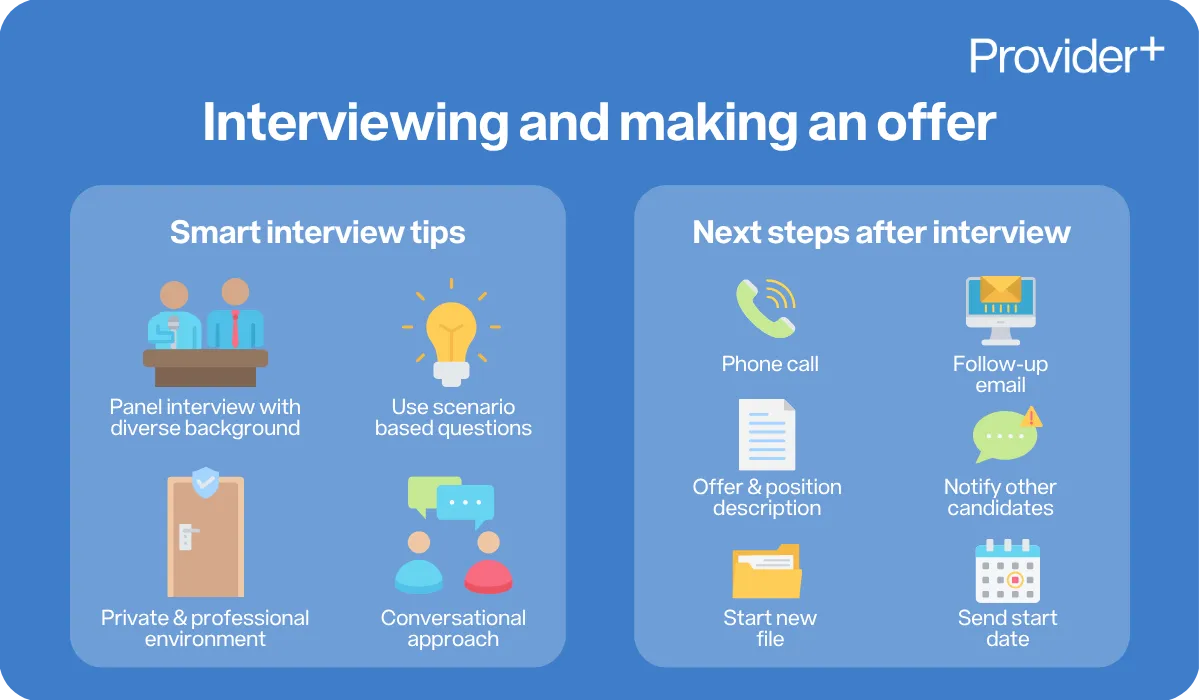
5. Making the Offer & Documentation
Once you have selected your preferred candidate, it is time to make a formal offer of employment. This process provides clarity, security, and legal protection for both your organisation and the worker. It sets out clear expectations regarding duties, conditions, pay, and compliance with the NDIS Code of Conduct, helping to build a professional, accountable workforce.
What to Include in Your Offer
- Letter of Engagement outlining employment terms
- Position Description
- Start date and conditions
- Orientation Plan to introduce new workers to your organisation’s values and culture
- Competitive pay to ensure fair compensation and retain top support workers
It is also best practice to respectfully notify unsuccessful applicants.
6. Worker File Checklist
Accurate worker records are essential for every NDIS provider. A valuable resource for new workers includes essential support materials and training programs that assist them in their roles. These should be kept securely to protect sensitive information and updated regularly. Having employed workers ensures that all workers adhere to NDIS registration requirements and are covered by insurance, providing a higher level of oversight and safety for clients.
What to Include in Every Worker File
7. Orientation & Onboarding
Orientation and onboarding play a crucial role in worker engagement and retention. It is essential to maintain high standards and ensure consistency throughout these processes. Providing ongoing support during a worker’s first 90 days is key to their retention, as it helps them feel valued and supported in their new role. Mentoring programs and wellbeing initiatives can also help new workers feel supported as they settle into their roles. Emphasising the importance of the beginning stages of onboarding can lead to long-term success in creating a positive work culture and achieving high-quality care outcomes.
What to Include
- Introduction to your team and participants
- Review of organisational policies and procedures
- Training on the NDIS Code of Conduct
- Completion of all required training modules
- Welcome Pack with key contacts and resources
- Access to resources that support worker in their roles
- Emphasis on the role of supporting people in delivering person-centred supports
8. Retaining NDIS Workers
Keeping great workers requires ongoing support, development, and recognition. By providing tools that allow you to independently manage support services, you can ensure your team feels empowered and valued.
Tips for Worker Retention
- Provide regular feedback and guidance
- Offer a variety of professional development opportunities
- Recognise worker achievements and contributions
- Encourage open communication
- Promote wellbeing and a healthy work-life balance
- Highlight that direct employment offers more choice and control
Providing opportunities for feedback helps workers feel valued and increases job satisfaction, fostering a more committed and motivated team.
Investing in your people helps reduce turnover and creates a stronger, more committed team. Offering wellness programs can help reduce burnout and improve worker retention, contributing to a healthier and more productive workplace.
Conclusion
Successful NDIS recruitment is not just about filling vacancies — it is about optimising the recruitment process to build a team that genuinely cares about their work and the people they support. With clear processes, thoughtful hiring practices, and a genuine commitment to worker wellbeing, NDIS providers can meet their responsibilities while creating a positive, supportive workplace. Additionally, building a strong support team, including a Coordinator or Relationship Manager, is crucial for coordinating services and ensuring clients have control over their support workers for a more personalised experience.
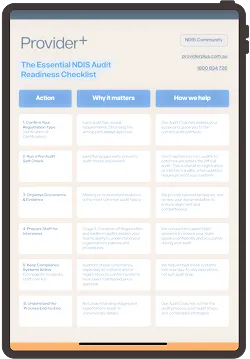
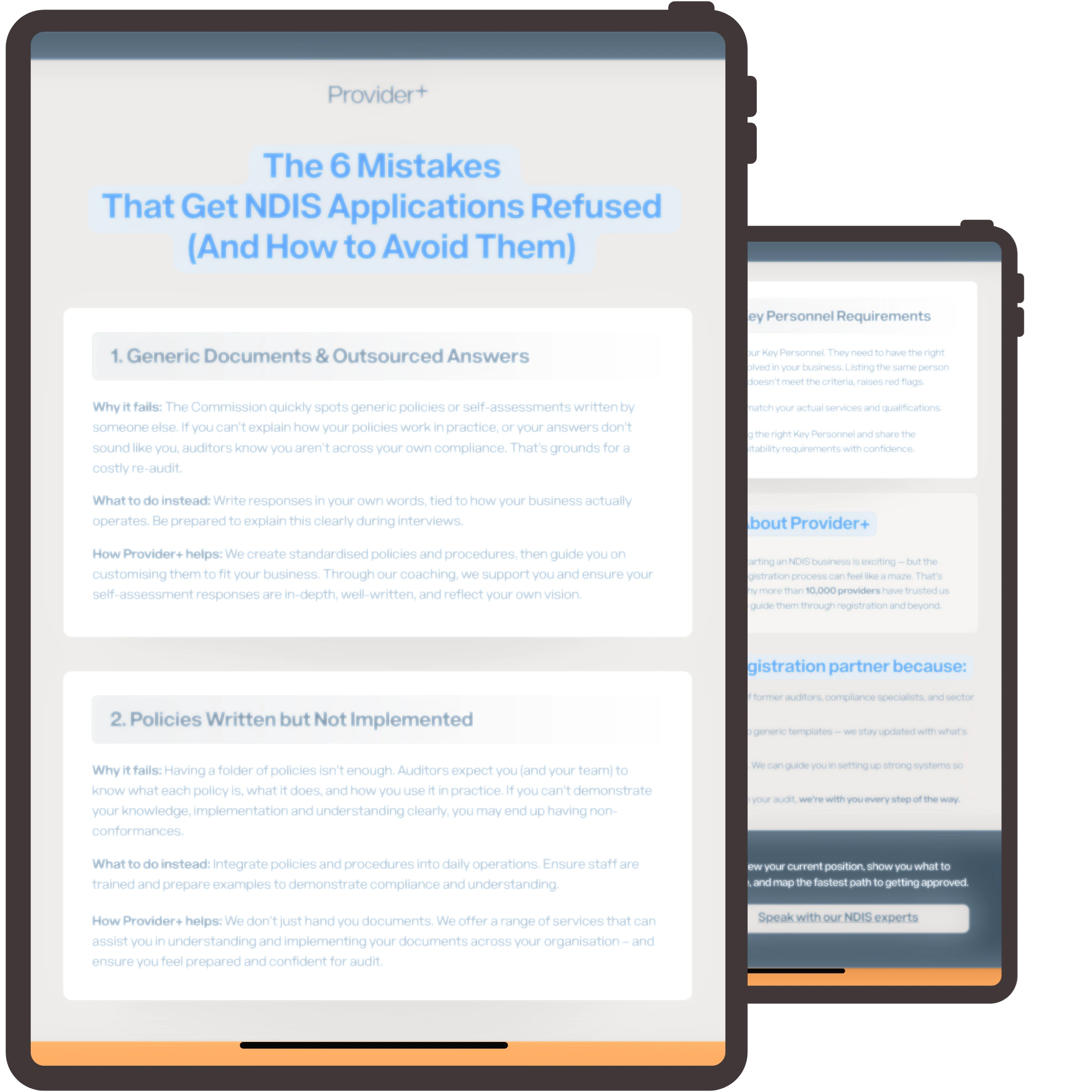
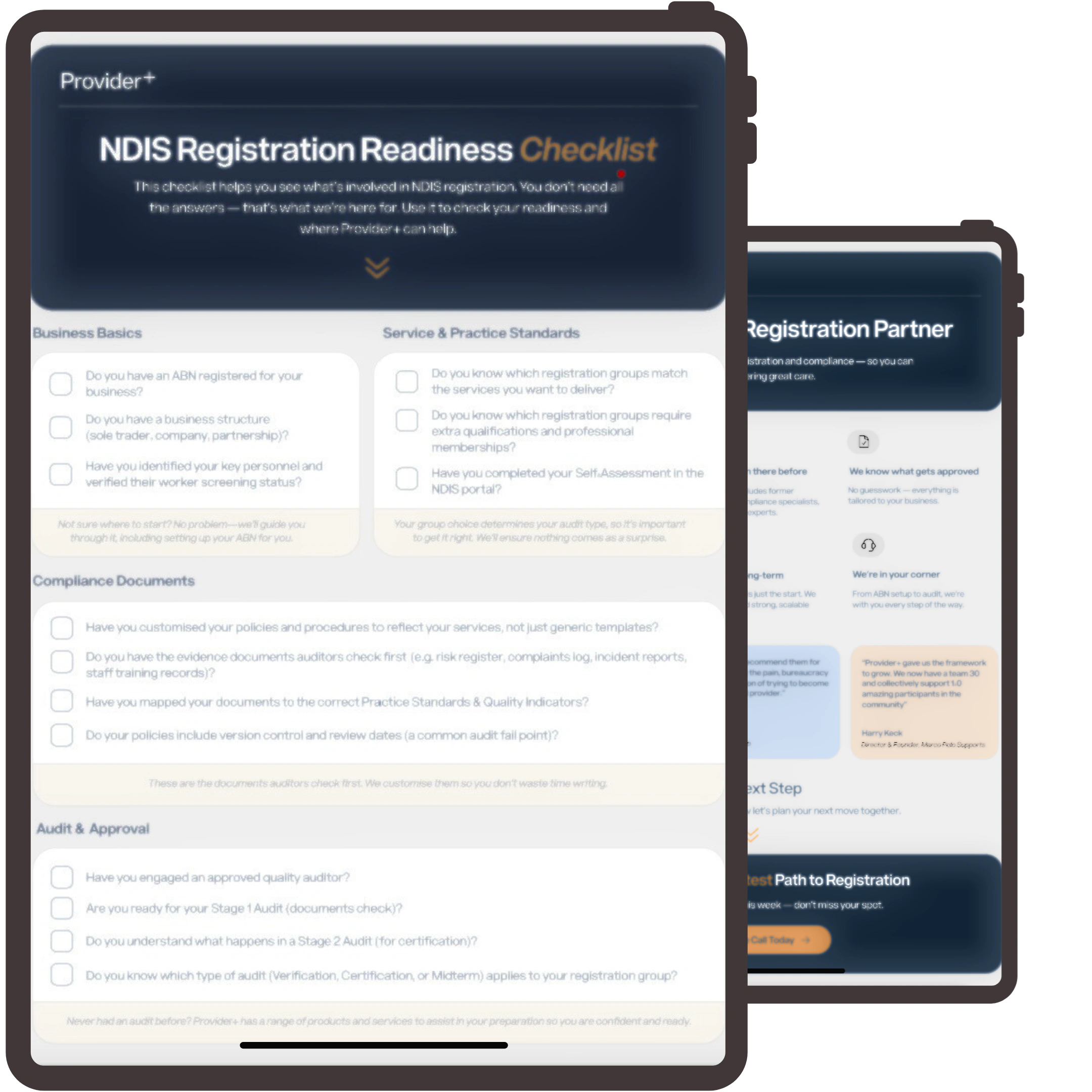

































FAQs
Here is our frequently asked questions.

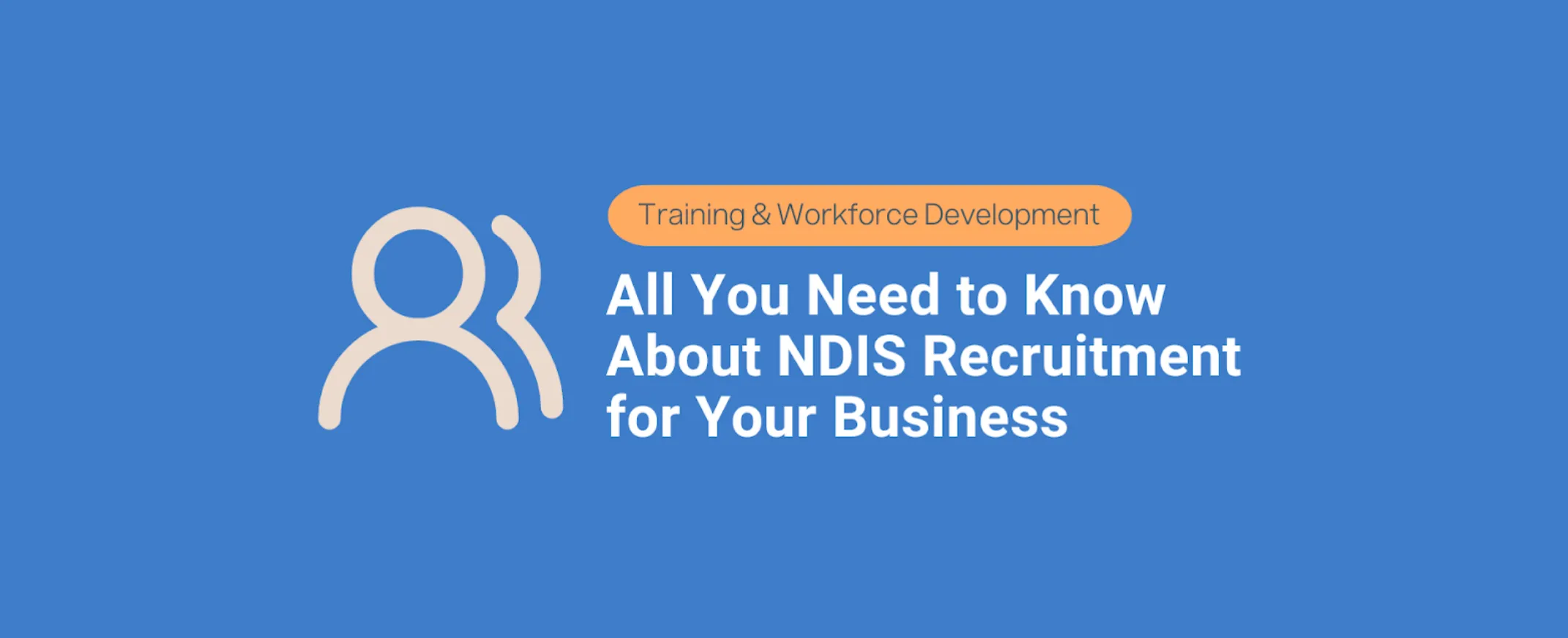
.webp)